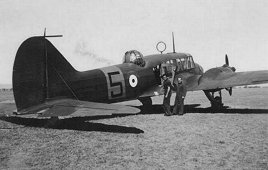
Avro Anson
The Avro Anson was initially developed in 1935 for Coastal Command as a land-based reconnaissance aircraft, but it was later destined to become the Allies most widely used trainer aircraft. The Anson, which made its maiden flight on March 1935 was based on the Avro 652 six-seat airliner. It entered service in 1936 and with a top speed of 303 kmh, it was at that time the Royal Air Force’s fastest twin engine aircraft. It was also the Royal Air Force’s first monoplane to feature retractable landing gears.
Shortly after its introduction, the Avro Anson began its career as an advanced trainer, where in 1940 it became the standard twin-engine trainer aircraft for pilots in Canada. The dorsal Paul Boulton turret above the fuselage and radar equipped Anson was also used for radar observation and air gunner training.
At the onset of war, the Anson played a vital role in the reconnaissance of the English Channel, North Sea and Western Approaches, protecting Allied shipping against the German U-boat threat. Although it had been superseded by the Hudson introduced in 1937, but a shortage of operational aircraft meant that the Anson continued to serve as Coastal Command’s main reconnaissance aircraft until 1942. From 1941 onwards, it was also used in an air-sea rescue role.
For combat service, the Anson was fitted with two machine guns – one forward firing and another in a dorsal turret above the fuselage. In addition, it carried a payload of two 45 kg (100 lbs) and eight 9 kg (20 lbs) bombs in its bomb bay. During a bombing run, the bombardier would peer downwards in the nose of the plane through the Winperis Mk VIIB bombsight.
Although it had been considered outclassed by 1940, but the Anson possessed good banking abilities, and was capable of tighter turns compared to the German Bf 109s. This capability enabled the Anson to shoot down six of the German fighters in combat.
The Anson was a very dynamic and highly successful aircraft with more than 11,000 units built. Nearly 3,000 of those were produced under license in Canada and after the war, many were converted to civil transports. It had served with at least 20 other air forces and continued production until 1952. Finally retired from the Royal Air Force in 1968, the Anson had served 32 years with the Royal Air Force, and became the longest service aircraft of the RAF.
 |
 |
 |
| The Avro Anson a played vital role in protecting British convoys against the German U-boat threat. It first saw combat on 5th September 1939, attacking a U-boat. |
By 1943, the Anson's primary role was training. It was fitted with radar for training observers and a Paul Boulton turret for training air gunners. |
Most widely used as a trainer, the Avro Anson equipped at least 20 other air forces, including Australia, Finland, Ireland and Greece. |
|
Avro Anson (Technical Specification) |
| Role |
Trainer, reconnaissance |
| Manufacturer |
Avro |
| Maximum Speed |
303 kmh (188 mph) |
| Maximum Range |
1,270 km (787 miles) |
| Ceiling |
5,790 meters (19,000 feet) |
Weight
Empty
Maximum Takeoff |
2,438 kg (5,361 lbs)
3,629 kg (7,984 lbs) |
Dimensions
Wingspan
Length
Height
Wing Area |
17.22 meters (56 ft, 6 in)
12.88 meters (42 ft, 3 in)
3.99 meters (13 ft, 1 in)
43 square meters (463 sq ft) |
| Engines |
Two Armstrong Siddeley Cheetah IX seven-cylinder air-cooled radial engines each providing 261-kW (350 hp) |
| Armament |
Two 7.7mm machine guns
Bomb capacity of 163 kg (360 lbs) |
Photo Gallery
Click here to submit your photo
| Have A Passion For Aircraft? |
Subscribe to our 14 series FREE newsletter
delivered weekly on World War 2 Aircraft factfile... |
| NB:- We hate spam as much as you do, so your email address will NEVER be shared with or sold to anyone else. That's a Guarantee. |
|
|






